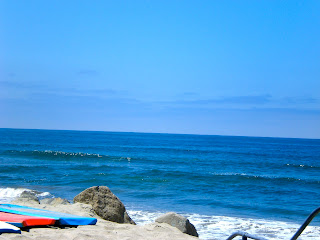The
beautiful landscape of Southern California is extremely varied, with high
mountains, huge deserts, sandy and rocky beaches, brushy hills, and broad river
valleys that are all relatively very close to each other. Southern California
is even more intriguing than its beautiful beaches and lush mountains, and dry
deserts.
The oldest rocks in the region exceed 1.5 billion years in age, and
have been affected by many cycles of metamorphism and deformation. Other places
in Southern California, recent volcanic activity has produced lots and lots of
fresh basalt so young that it has barely begun to weather. The sedimentary
rocks of southern California are extremely varied and include materials that
originally collected in deep oceans, shallow seas, riverbeds, lakes, beaches,
sand dunes, and alluvial fans.

Sedimentary Rock found in Southern California http://www.google.com/imgres?q=sedimentary+rock&um=1&hl=en&client=safari&sa
The mountains in southern California are
actually very young and have formed through normal faulting under tension in
the Basin and Range, folding and reverse faulting generated by compression in
the Transverse Range, and through faulting related to stress in several places
along the San Andreas fault zone. Also in Southern California great quantities
of alluvium have been deposited across the floor of the San Joaquin Valley by
rivers draining the close highlands. This alluvium, derived from the weathering
of granitic rocks in the Sierra Nevada, it is responsible for the fertile soils
of the valley. The natural fertility of the San Joaquin soils in parts reflects
the mineral nutrients released during chemical weathering. The San Joaquin soil
has been designated the official California State Soil.
The interesting
physical geography is a result of the beautiful oceans and mountains and other
vast areas of Southern California. Through this course I have learned so much
about many beautiful area’s why they are there what are results of things
forming and moving and for how they look like the way they are. I never
realized how much fun Physical Geography could be!
The next 100 years in
Southern California
In
the next 100 years the sea is bound to rise in Southern California. For
at least the past 20,000 years, sea level has been rising as an ongoing episode
of global warming and related glacial and icecap melting and retreat. During the last several decades, from the small set
of California tide gages, the sea around Southern California are rising about
20 cm per century, very similar to the estimated for the global average sea
level. The combination of predicted astronomical tides with projected weather
forcing, El Nino related variability and given sea level projections from
2005-2100 are showing evidence of the sea level rising. As well as the gradual
sea level rise worsens the impacts of high tides and the surge and waves
associated with storms and s well as the fresh water floods from Sierra and
costal mountain catchments. This rise in sea level in California can affect
beach properties, many famous landmarks, homes, people and slowly a lot of
built architecture. California in our time will not be breaking off but the sea
level rising is real and will start to be affected during our lifetime.
http://cengagesites.com/academic/assets/sites/4004/DeCourten_1424067871_LowRes.pdf
Oceanside where the Grandparent's live!

